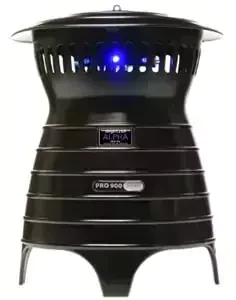How do Mosquito Traps Work?

Several brands of mosquito traps are designed to lure mosquitoes by mimicking human breath and trap them in a net or container, where they die of dehydration or drown. The idea works well when you want to get rid of mosquitoes in a particular area like your backyard, but can’t prevent them from breeding elsewhere, since traps kill adult mosquitoes looking for a meal, no matter where they come from.
Since only female mosquitoes bite, and they need a meal of blood before they can develop eggs, catching them at the moment they’re looking for blood will kill them before they can reproduce, and therefore will prevent the next generation of mosquitoes too.
Traps won’t catch every mosquito in the area, especially if there are people or animals nearby too. But if you place one in the right location and run it every day at the times that mosquitoes are out, it will start to cut back on problems in a few days and mosquito numbers should continue to drop even more as the season progresses.
Pretending to Exhale

Traps work by mimicking an animal or person, sending out the signals that mosquitoes use to find their prey. The main signal is a plume of carbon dioxide (CO2), as if an animal is exhaling. Some traps send off a steady amount, while others like the Mega Catch traps match the rhythm of breathing. The trap can either use propane to make carbon dioxide, or use a CO2 cylinder. In addition, traps may use an attractant such as Octenol or Lurex.
Octenol, Lurex and Lactic Acid

Octenol is an attractant that makes the plume of CO2 seem even more like human breath. Chemically, it’s 1-octen-3-ol or C8H160, and is formed when linoleic acid is broken down by the body. It’s also produced by some fungi, including edible mushrooms, so another name for it is “mushroom alcohol.” It has been approved by the FDA as a synthetic flavoring to be added to food, and it’s also used in perfume. Mosquitoes and other insects can sense it, so it attracts them, as well as black flies and no-see-ums.
The EPA fact sheet reports that octenol is “not harmful to humans, to other non-target organisms, or to the environment” when it is released into the air. The octenol containers themselves should be kept away from children and pets, since there’s a possibility of toxicity if they’re eaten.
Lurex is similar, but specially made to attract Asian tiger mosquitoes. It contains lactic acid, another substance that studies have shown will attract mosquitoes. Companies recommend using octenol in the northern states and Lurex in southern states where the Asian tiger mosquito is a problem, but Mega-Catch has come up with a “3000 Combo Lure” which combines both.

Trap users have discovered a way to make their own combination of scents, by adding limburger or other strong-smelling cheese to a trap already using octenol. Sour milk would probably do the same thing, since lactic acid produces the characteristic sour milk smell.
Don’t think that a mosquito trap smells like somebody with horrible bad breath, though! Mosquitoes can sense these odors in tiny trace amounts that you wouldn’t even notice, so that’s all the trap needs.
Location, Location, Location
Where you place a mosquito trap makes all the difference in how well it will work. First, figure out how mosquitoes are getting to the area you want to protect. They usually spend the day resting in bushes, high grass or shady areas, and come out from these places in the evening when they want to look for someone to bite. Also, they emerge as adults from larvae living in water, so they may be coming from wetlands, drainage ditches, puddles in irrigated fields, or even water trapped in tree holes or other small places.

Wherever the mosquitoes start on their journey toward food, they’ll tend to fly upwind, following a plume of carbon dioxide that’s drifting toward them and which they hope is from a person or animal. So figure out which way the prevailing wind tends to blow in your area. The old trick of standing outside, wetting your finger, holding it up and feeling the cold side works. The cold side would be the upwind side.
When you know the usual wind direction, look for a location that’s upwind from where the mosquitoes enter, and at least thirty feet from the people you don’t want them to bite. That way, when they emerge to look for a meal, they should notice the plume of carbon dioxide from the trap, follow it upwind, but find the trap before they find you.
Since carbon dioxide is heavier than air, it disperses close to the ground. Therefore, an ideal trap location has a clear, level area around it, especially on the downwind side, so the carbon dioxide will spread as far as possible.
Placing the trap in a shady area will encourage mosquitoes to seek it out sooner, since they prefer to avoid the hot, bright sun, and will choose a victim in the shade before venturing into the sunlight.
To summarize, the best trap location is:
- Between the area you want to protect and the area where mosquitoes are resting or breeding
- At least 30 feet from the area you want to protect
- Upwind from the mosquitoes’ resting or breeding area
- In an area without high grass, hedges, or other barriers so the carbon dioxide can spread
- In a cool, damp or shady area, rather than a hot, dry, sunny one.
Experiment with different locations, keeping the guidelines in mind, and see which works best.

